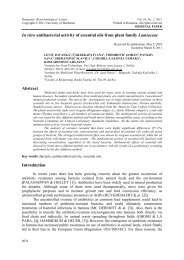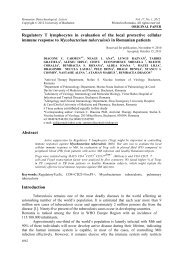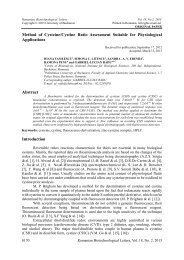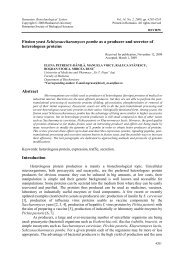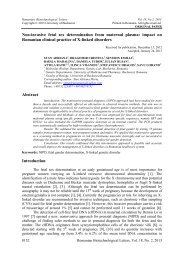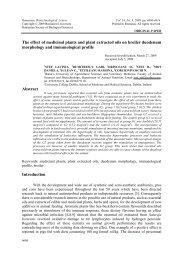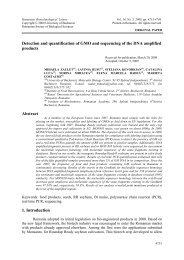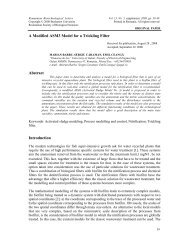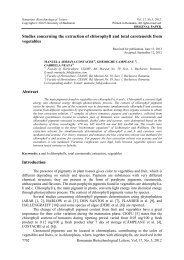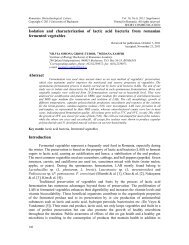Rhizobium and plant growth-promoting bacteria - ResearchGate
Rhizobium and plant growth-promoting bacteria - ResearchGate
Rhizobium and plant growth-promoting bacteria - ResearchGate
You also want an ePaper? Increase the reach of your titles
YUMPU automatically turns print PDFs into web optimized ePapers that Google loves.
Romanian Biotechnological Letters Vol. 16, No. 1, 2011<br />
Copyright © 2011 University of Bucharest<br />
Printed in Romania. All rights reserved<br />
ORIGINAL PAPER<br />
Improvement of common bean <strong>growth</strong> by co-inoculation with <strong>Rhizobium</strong><br />
<strong>and</strong> <strong>plant</strong> <strong>growth</strong>-<strong>promoting</strong> <strong>bacteria</strong><br />
Received for publication, August 22, 2010<br />
Accepted, January 31, 2011<br />
OLIVERA STAJKOVIĆ 1* , DUŠICA DELIĆ 1 , DRAGANA JOŠIĆ 1 , ĐORĐE<br />
KUZMANOVIĆ 1 , NATAŠA RASULIĆ 1 , JELENA KNEŽEVIĆ-VUKČEVIĆ 2<br />
1 Institute of Soil Science, Teodora Drajzera 7, Belgrade, Serbia<br />
2 Faculty of Biology, University of Belgrade, Studentski trg 16, Belgrade, Serbia<br />
* Correspondence to: oliverastajkovic@yahoo.com; Tel/fax: +381 11 2667 123<br />
Abstract<br />
In the greenhouse experiment, two Bacillus <strong>and</strong> two Pseudomonas strains were examined for<br />
their ability to promote common bean <strong>growth</strong> (Phaseolus vulgaris L.) when co-inoculated with<br />
<strong>Rhizobium</strong> phaseoli. Co-inoculation with <strong>Rhizobium</strong> <strong>and</strong> Pseudomonas sp. LG or Bacillus sp. Bx<br />
improved shoot dry weight, nitrogen <strong>and</strong> phosphorus contents in bean <strong>plant</strong>s, compared to inoculation<br />
with <strong>Rhizobium</strong> alone. Pseudomonas sp. LG promoted bean <strong>growth</strong> <strong>and</strong> particularly P uptake more<br />
efficiently than Bacillus sp. Bx. In vitro screening for <strong>plant</strong> <strong>growth</strong>-<strong>promoting</strong> traits showed phosphate<br />
solubilization, IAA, ammonia <strong>and</strong> siderophore production by Pseudomonas sp. LG, as opposed to<br />
Bacillus sp. Bx, which showed only ammonia production. Multiple <strong>plant</strong> <strong>growth</strong>-<strong>promoting</strong> traits of<br />
Pseudomonas sp. LG may be associated with its ability to improve common bean <strong>growth</strong> <strong>and</strong> nutrient<br />
uptake efficiently.<br />
Keywords: common bean, <strong>plant</strong> <strong>growth</strong> promotion, co-inoculation<br />
Introduction<br />
Leguminous <strong>plant</strong>s include many important species that are used as food <strong>and</strong> fodder<br />
crop throughout the world. They can provide their own nitrogen requirements through<br />
nitrogen fixation in symbiosis with soil <strong>bacteria</strong> collectively known as rhizobia. These<br />
<strong>bacteria</strong> form root nodules on leguminous <strong>plant</strong>s <strong>and</strong> convert atmospheric N 2 into a form<br />
usable by <strong>plant</strong>s. Application of effective rhizobial strains as biofertilizers to improve legume<br />
production is an important approach in sustainable agriculture.<br />
Many studies have recently shown that inoculation with some <strong>plant</strong> <strong>growth</strong>-<strong>promoting</strong><br />
<strong>bacteria</strong> (PGPB), increases <strong>growth</strong> <strong>and</strong> yield in great number of <strong>plant</strong>s including legumes [1,<br />
2, 3]. PGPB can contribute to <strong>plant</strong> <strong>growth</strong> in different manners: by increasing nitrogen<br />
uptake, synthesis of phytohormones (auxin, cytokinin), minerals solubilization <strong>and</strong> iron<br />
chelation [4, 5, 6, 7]. They may suppress soil-borne pathogens by producing siderophores,<br />
antimicrobial metabolites, or competing for nutrients <strong>and</strong>/or niches [8]. PGPB also have<br />
beneficial effects on legume <strong>growth</strong>, <strong>and</strong> at least some strains enhance nodulation <strong>and</strong><br />
nitrogen fixation by affecting interactions between <strong>plant</strong> <strong>and</strong> rhizobia. Available reports<br />
indicate improved legumes yield, health <strong>and</strong> nodulation when co-inoculated with PGPB,<br />
compared to inoculation with rhizobium alone [5, 9, 10, 11].<br />
Beans are the most important grain legumes for direct human consumption in the<br />
world. In nutritional terms, beans are great protein source <strong>and</strong> they are rich in minerals<br />
(especially iron <strong>and</strong> zinc) <strong>and</strong> vitamins [12]. Symbiotic nitrogen fixing potential in common<br />
bean is considered to be low in comparison with other legumes. However, owing to genotypic<br />
variability for traits associated with N 2 fixation potential selection has produced breeding<br />
5919
OLIVERA STAJKOVIĆ, DUŠICA DELIĆ, DRAGANA JOŠIĆ, ĐORĐE KUZMANOVIĆ,<br />
NATAŠA RASULIĆ, JELENA KNEŽEVIĆ-VUKČEVIĆ<br />
lines able to fix high levels of N 2 . The selection of particular rhizobial strains with high<br />
nitrogen fixing potential is also important [13]. Phosphorus has a considerable influence on<br />
the legume-rhizobia symbiosis. Positive effects of P on nodulation <strong>and</strong> nitrogenase activity in<br />
common bean were observed. Nitrogen fixation in common bean is more affected by P<br />
deficiency than in other legume crops [14, 15]. Taking into account that some PGPB possess<br />
ability of phosphate solubilization, they could be useful in bean production improvement by<br />
increasing P content in the soil <strong>and</strong> enhancing nodulation <strong>and</strong> N fixation.<br />
The aim of this research was to determine if the co-inoculation of common bean with<br />
<strong>Rhizobium</strong> phaseoli <strong>and</strong> some Pseudomonas, as well as Bacillus strains can improve <strong>plant</strong><br />
<strong>growth</strong> <strong>and</strong> nutrient uptake. In addition, the <strong>bacteria</strong>l strains were examined for their <strong>plant</strong><br />
<strong>growth</strong>-<strong>promoting</strong> traits.<br />
Material <strong>and</strong> methods<br />
Bacterial strains <strong>and</strong> <strong>growth</strong> conditions<br />
Strains luc2, LG <strong>and</strong> SNji were isolated from alfalfa root nodules, while Bx strain was<br />
isolated from soil rhizosphere. The identification of isolates to the genus level was performed<br />
by st<strong>and</strong>ard microbiological procedure [16]. <strong>Rhizobium</strong> phaseoli strain 123 (the Collection of<br />
Institute of Soil Science, Belgrade) was selected for its high capacity to fix nitrogen in<br />
symbiosis with common bean. For the inoculation study R. phaseoli strain was cultivated in<br />
yeast mannitol broth (YMB), Bacillus strains in nutrient broth medium <strong>and</strong> Pseudomonas<br />
strains in King B medium, in the 250 ml flasks shaken at 125 rpm at 28 ˚C. The 78 h old<br />
culture of R. phaseoli <strong>and</strong> 24 h old cultures of others strains were used as inoculants.<br />
Screening for <strong>plant</strong> <strong>growth</strong>-<strong>promoting</strong> traits<br />
Detection of phosphate solubilizing ability. Bacterial strains were tested by plate assay<br />
using Pikovskaya medium (PVK) <strong>and</strong> National Botanical Research Institute’s phosphate<br />
<strong>growth</strong> medium (NBRIP) [17, 18]. Strains were stabbed on plate in triplicate using sterile<br />
toothpicks. The halo appearing around the colony after 7 days of incubation at 28 ˚C indicates<br />
P solubilization ability of strains. Halo size was calculated by subtracting colony diameter<br />
from the total diameter.<br />
Detection of ammonia. Bacterial isolates were tested for the production of ammonia in<br />
peptone water. Freshly grown cultures were inoculated in 10 ml peptone water in tubes <strong>and</strong><br />
incubated for 48–72 h at 28 ˚C. Nessler’s reagent (0.5 ml) was added in each tube. The<br />
development of color from yellow to brown was a positive test for ammonia production.<br />
Siderophore detection. Siderophore production was determined in appropriate medium<br />
according to the Milagres et al. procedure [19]. Color change of the medium from blue to<br />
orange is an indication of siderophore production by <strong>bacteria</strong>l strains.<br />
Test of IAA production ability. The strains for indole-3-acetic acid (IAA) detection<br />
were grown in nutrient broth medium or YMA (<strong>Rhizobium</strong>), supplemented with tryptophan (2<br />
mg ml -1 ), at 28 ˚C for 5 <strong>and</strong> 7 days respectively. Cultures were centrifuged <strong>and</strong> the two ml of<br />
supernatant was mixed with 2 ml of reagent which consisted of 4.5 g of FeCl 3 per litre in 10.8<br />
M H 2 SO 4 . Development of a pink color indicates IAA production.<br />
Evaluation of common bean <strong>growth</strong> when co-inoculated with <strong>Rhizobium</strong> <strong>and</strong> PGPB strains<br />
The co-inoculation effects of PGPB <strong>and</strong> <strong>Rhizobium</strong> strains on bean <strong>growth</strong> were<br />
examined in pot experiment under greenhouse conditions, using non-sterile soil with no<br />
history of bean cultivation. The soil used had the following characteristics: pH (in H 2 O) 7.4,<br />
0.09 % N, 1.48 % C, 21 mg kg -1 available P. The experiment was designed with 5 co-<br />
5920 Romanian Biotechnological Letters, Vol. 16, No. 1, 2011
Improvement of common bean <strong>growth</strong> by co-inoculation with<br />
<strong>Rhizobium</strong> <strong>and</strong> <strong>plant</strong> <strong>growth</strong>-<strong>promoting</strong> <strong>bacteria</strong><br />
inoculated treatments with 5 replications in a completely r<strong>and</strong>omized system. Controls<br />
without inoculation (without mineral nitrogen (Ø) <strong>and</strong> with full N content (NØ)) <strong>and</strong><br />
nodulation control inoculated with <strong>Rhizobium</strong> phaseoli strain 123 alone were included for<br />
comparison. The experiment was performed in 24 cm diameter plastic pots filled with soil.<br />
Common bean seeds (Phaseolus vulgaris L. cultivar Biser) were surface-sterilized with 0.1%<br />
HgCl 2 solution [20] <strong>and</strong> inoculated either with R. phaseoli strain alone, or with a Bacillus <strong>and</strong><br />
Pseudomonas strains in a ratio of 1:1. Five seeds per pot were <strong>plant</strong>ed <strong>and</strong> thinning of the<br />
seedlings to 3 was done after 2 weeks. The pots were kept in a closed greenhouse in semicontrolled<br />
conditions for two months, <strong>and</strong> the <strong>plant</strong>s were harvested in the flowering phase.<br />
Roots were carefully removed from the pots, washed free of soil <strong>and</strong> the root <strong>and</strong> shoot<br />
portions of bean were separated <strong>and</strong> measured. The number of nodules <strong>and</strong> shoot <strong>and</strong> root<br />
length were recorded. Plant shoots, roots <strong>and</strong> nodules were dried in an oven at 70 ˚C to<br />
constant weight <strong>and</strong> the average dry weight per <strong>plant</strong> was calculated. Symbiotic nitrogen<br />
fixing efficiency (SNF) was calculated as an increase in SDW in relation to SDW of NØ<br />
<strong>plant</strong>s (100%). The percentage of shoot N was determined from dried <strong>and</strong> grinded <strong>plant</strong><br />
samples using the CNS analyser (Vario model EL III (ELEMENTAR Analysensysteme<br />
GmbH, Hanua, Germani)) <strong>and</strong> it was used to calculate total N content in mg per <strong>plant</strong>. In<br />
<strong>plant</strong> material samples the P content was determined by dry ashing at 550 ˚C <strong>and</strong> acid<br />
digestion, after which, P was determined colorimetrically. The data were statistically<br />
processed by the LSD <strong>and</strong> Duncan test using SPSS 10.0 computer program.<br />
Results <strong>and</strong> discussion<br />
Plant <strong>growth</strong>-<strong>promoting</strong> traits<br />
Bacterial strains used in this study, luc2, LG <strong>and</strong> SNji, originated from alfalfa root<br />
nodules <strong>and</strong> represent non-rhizobial nodule endophytes. Two of these strains, luc2 <strong>and</strong> LG,<br />
were found to belong to the genus Pseudomonas, while SNji strain was previously determined<br />
as Bacillus megaterium [21]. Strain Bx was isolated from soil rhizosphere <strong>and</strong> determined as<br />
Bacillus sp. Initial screening for <strong>plant</strong> <strong>growth</strong>-<strong>promoting</strong> traits demonstrated that all strains<br />
were positive for ammonia production (Table 1). Strains Pseudomonas spp. luc2 <strong>and</strong> LG<br />
produced siderophores intensively, <strong>and</strong> could strongly solubilize phosphate in both PVK <strong>and</strong><br />
NBRIP media, together with <strong>Rhizobium</strong> strain which was however less efficient. <strong>Rhizobium</strong>,<br />
as well as LG <strong>and</strong> SNji strains produced IAA. Bacillus sp. Bx did not show any of the <strong>plant</strong><br />
<strong>growth</strong> promotion traits tested, except ammonia production.<br />
Table 1- Some <strong>plant</strong> <strong>growth</strong>-<strong>promoting</strong> traits of <strong>bacteria</strong>l strains.<br />
Strain<br />
P solubilization * NH 3 IAA Siderophore<br />
PVK NBRIP production<br />
<strong>Rhizobium</strong> phaseoli 0 3 - + -<br />
Bacillus megaterium SNji 1.5 0 + + -<br />
Bacillus sp. Bx 0 0 + - -<br />
Pseudomonas sp. luc2 10 13 + - +<br />
Pseudomonas sp. LG 10 15 + + +<br />
* diameter of halo in mm; +, positive reaction; -, negative reaction.<br />
Plant <strong>growth</strong> <strong>and</strong> inoculation in non-sterile soil<br />
Pot experiment with non-sterile soil showed a significant effect of some PGPB strains<br />
when co-inoculated with <strong>Rhizobium</strong> on nodulation <strong>and</strong> <strong>growth</strong> parameters of bean in respect<br />
to inoculation with <strong>Rhizobium</strong> alone.<br />
Romanian Biotechnological Letters, Vol. 16, No. 1, 2011 5921
OLIVERA STAJKOVIĆ, DUŠICA DELIĆ, DRAGANA JOŠIĆ, ĐORĐE KUZMANOVIĆ,<br />
NATAŠA RASULIĆ, JELENA KNEŽEVIĆ-VUKČEVIĆ<br />
Co-inoculation of bean with Bacillus strains SNji <strong>and</strong> Bx was found to positively<br />
influence nodule number (106.67 <strong>and</strong> 76.67 nodule number <strong>plant</strong> -1 , respectively) (Table 2),<br />
<strong>and</strong> in the case of SNji nodule dry weight also (90.33 mg <strong>plant</strong> -1 ), compared to inoculation<br />
with <strong>Rhizobium</strong> alone (54 nodule number <strong>plant</strong> -1 <strong>and</strong> 53.12 mg <strong>plant</strong> -1 ). Maximum nodule<br />
number recorded in the <strong>Rhizobium</strong> <strong>and</strong> SNji co-inoculation doubled compared to the<br />
<strong>Rhizobium</strong> control. High positive correlation between nodule number <strong>and</strong> nodule dry weight<br />
was noted (Table 4).<br />
Table 2. Average nodule number, nodule dry weight, shoot <strong>and</strong> root length <strong>and</strong> root dry weight of inoculated<br />
common bean <strong>plant</strong>s.<br />
Treatment Nodule Nodule dry weight Shoot height Root length Root dry weight<br />
N o <strong>plant</strong> -1 (mg <strong>plant</strong> -1 ) (cm) (cm) (g <strong>plant</strong> -1 )<br />
<strong>Rhizobium</strong> 54.33 c 53.12 b 127.57 b 31.83 a 0.920 a<br />
<strong>Rhizobium</strong> + SNji 106.67 a 90.33 a 127.14 bc 31.05 a 0.829 a<br />
<strong>Rhizobium</strong> + Bx 76.67 b 63.67 b 115.97 d 32.00 a 0.870 a<br />
<strong>Rhizobium</strong> + luc2 59.02 c 55.93 b 119.77 bcd 38.52 a 0.973 a<br />
<strong>Rhizobium</strong> + LG 63.25 c 56.67 b 113.70 d 36.09 a 0.900 a<br />
MIX 57.00 c 54.57 b 127.27 bc 33.70 a 0.822 a<br />
Ø 34.51 d 30.33 c 119.35 cd 33.73 a 0.504 b<br />
NØ 27.22 d 31.61 c 140.49 a 37.07 a 0.841 a<br />
LSD 0.05 8.44 9.39 7.52 7.51 0.131<br />
Non-inoculated controls: NØ-with N <strong>and</strong> Ø-without N; MIX- mixture of all strains; a-d: Means in a column<br />
followed by the same letter are not significantly different according to Duncan’s multiple range test at the 5%<br />
level (p≤0.05).<br />
The maximum bean shoot height was recorded in the NØ control (140 cm) <strong>and</strong> it was<br />
significantly superior to all other treatments tested. On the other h<strong>and</strong>, the maximum root<br />
length was detected with luc2 strain co-inoculation, but without significant differences. There<br />
was no correlation between shoot height <strong>and</strong> root length.<br />
Table 3. Average shoot dry weight, total <strong>and</strong> fixed N content, P content of inoculated common bean <strong>plant</strong>s<br />
indicating <strong>plant</strong> <strong>growth</strong>-<strong>promoting</strong> potential of strains.<br />
Treatment<br />
Shoot dry weight<br />
(g <strong>plant</strong> -1 )<br />
Symbiotic<br />
efficiency<br />
(%)<br />
Shoot<br />
N<br />
(%)<br />
Shoot total<br />
N content<br />
(mg <strong>plant</strong> -1 )<br />
Shoot fixed<br />
N content<br />
(mg <strong>plant</strong> -1 )<br />
Shoot P<br />
(%)<br />
Shoot P<br />
content<br />
(mg <strong>plant</strong> -1 )<br />
<strong>Rhizobium</strong> 2.40 c 101.27 2.34 56.11 c 14.31 c 0.59 14.16 de<br />
<strong>Rhizobium</strong> + SNji 2.41 c 101.69 2.17 52.30 c 10.45 d 0.65 15.67 cd<br />
<strong>Rhizobium</strong> + Bx 2.75 b 116.03 2.65 72.87 a 31.03 a 0.70 19.25 bc<br />
<strong>Rhizobium</strong> + luc2 2.37 c 100.00 2.18 51.67 b 9.82 d 0.74 17.54 bcd<br />
<strong>Rhizobium</strong> + LG 3.07 a 129.54 2.36 72.45 a 30.60 a 0.90 27.63 a<br />
MIX 2.57 bc 108.44 2.53 65.02 b 23.17 b 0.79 20.30 b<br />
Ø 1.86 d 74.26 2.35 41.85 d / 0.60 11.16 e<br />
NØ 2.37 c 100.00 2.14 50.72 c / 0.83 19.67 bc<br />
LSD 0.05 0.21 7.40 3.44 3.81<br />
Non-inoculated controls: NØ-with N <strong>and</strong> Ø-without N; MIX- mixture of all strains; a-e: Means in a column<br />
followed by the same letter are not significantly different according to Duncan’s multiple range test at the 5%<br />
level (p≤0.05).<br />
Average shoot dry weight (SDW), total <strong>and</strong> fixed N contents in <strong>plant</strong>s were used for<br />
quantitative <strong>and</strong> qualitative symbiotic nitrogen fixing efficiency (SNF) assessment as well as<br />
<strong>plant</strong> <strong>growth</strong>-<strong>promoting</strong> effect (Table 3). Plants inoculated with <strong>Rhizobium</strong> strain alone<br />
achieved similar SDW to control <strong>plant</strong>s with N (NӨ), indicating its significant nitrogen fixing<br />
5922 Romanian Biotechnological Letters, Vol. 16, No. 1, 2011
Improvement of common bean <strong>growth</strong> by co-inoculation with<br />
<strong>Rhizobium</strong> <strong>and</strong> <strong>plant</strong> <strong>growth</strong>-<strong>promoting</strong> <strong>bacteria</strong><br />
potential (Table 3). Co-inoculation of common bean with <strong>Rhizobium</strong> <strong>and</strong> Bx strain, as well as<br />
with <strong>Rhizobium</strong> <strong>and</strong> LG strain significantly increased SDW of <strong>plant</strong>s (2.75 <strong>and</strong> 3.07 mg <strong>plant</strong> -<br />
1 , respectively), in respect to <strong>Rhizobium</strong> inoculation alone, showing the potential of these<br />
strains to improve dry matter accumulation over <strong>Rhizobium</strong> alone. Elevated N content was<br />
also detected in these two treatments <strong>and</strong> both strains showed the same N content per <strong>plant</strong>,<br />
regardless of the higher SDW in LG treatment. Shoot dry weight values were in a highly<br />
significant positive correlation with shoot total N (r=0.929).<br />
The highest root dry weight (RDW) was recorded by co-inoculation with <strong>Rhizobium</strong><br />
<strong>and</strong> luc2 (0.973 mg <strong>plant</strong> -1 ) however, there was no significant improvement in RDW by coinoculation<br />
in respect to the inoculation with <strong>Rhizobium</strong> alone.<br />
The shoot P content was highly affected by co-inoculation with LG strain which<br />
showed phosphate solubilizing activity in vitro. Inoculation with other efficient phosphate<br />
solubilizing strain luc2 also increased the percentage of shoot P but not as much as LG strain<br />
<strong>and</strong> without positive effect on SDW increase. The P content in shoot was also somewhat<br />
elevated by Bx strain although its P solubilizing activity was not detected in this study.<br />
Significant correlation between P <strong>and</strong> total N content in the shoot was noted.<br />
Table 4. Correlation (r) between parameters of nitrogen fixation.<br />
Shoot DW Root DW Nodule Nodule Shoot total Shoot Shoot Root<br />
number DW N P length length<br />
Shoot DW 1.000<br />
Root DW 0.662 * 1.000<br />
Nodule number 0.383 0.337 1.000<br />
Nodule DW 0.407 0.437 0.989 *** 1.000<br />
Shoot total N 0.929 *** 0.512 0.353 0.350 1.000<br />
Shoot P 0.902 *** 0.519 0.095 0.124 0.771 ** 1.000<br />
Shoot length -0.331 0.040 -0.316 -0.229 -0.431 -0.207 1.000<br />
Root length 0.063 0.241 -0.532 -0.487 -0.124 0.396 0.054 1.000<br />
*P < 0.05 (significant), ** P < 0.01 (highly significant), *** P < 0.001 (extremely significant).<br />
The use of <strong>plant</strong> <strong>growth</strong>-<strong>promoting</strong> <strong>bacteria</strong> to increase the soil fertility <strong>and</strong> improve<br />
<strong>growth</strong> <strong>and</strong> yield of agronomical important crops is a significant alternative to chemical<br />
fertilizers in sustainable agriculture. Strains of the Pseudomonas <strong>and</strong> Bacillus genera are the<br />
most well-known PGPB, which when co-inoculated with <strong>Rhizobium</strong> can improve <strong>growth</strong> of<br />
different legumes, including bean [22, 23, 24, 25].<br />
In the present work, the results showed improved common bean <strong>growth</strong>, nitrogen<br />
fixation <strong>and</strong> phosphorous uptake when co-inoculated with Pseudomonas sp. LG, as well as<br />
Bacillus sp. Bx in respect to the inoculation with <strong>Rhizobium</strong> alone. The highest shoot dry<br />
weight as the main indicator of nitrogen fixing ability <strong>and</strong> <strong>growth</strong> promotion [26, 27] was<br />
detected in <strong>plant</strong>s co-inoculated with <strong>Rhizobium</strong> <strong>and</strong> LG strain. The SDW increase of 29.54%<br />
over <strong>Rhizobium</strong> control was statistically significant, compared to <strong>Rhizobium</strong> inoculation<br />
alone, indicating considerable <strong>plant</strong> <strong>growth</strong>-<strong>promoting</strong> effect of LG strain.<br />
Most of the tested PGPB strains are isolated from rhizosphere <strong>and</strong> represent PGPR.<br />
However, some endophytic <strong>bacteria</strong> also have the potential of <strong>plant</strong> <strong>growth</strong> promotion [28, 29,<br />
30]. Moreover, Pseudomonas strains were often isolated from root nodules of leguminous<br />
<strong>plant</strong>s <strong>and</strong> some of them showed <strong>plant</strong> <strong>growth</strong> potential [29, 31, 32], which was the case with<br />
LG strain in our research.<br />
Various direct <strong>and</strong> indirect mechanisms of <strong>plant</strong> <strong>growth</strong> promotion have been<br />
associated with Pseudomonas <strong>and</strong> Bacillus strains capable of enhancing <strong>plant</strong> <strong>growth</strong>. In the<br />
present study, Pseudomonas sp. LG showed multiple <strong>plant</strong> <strong>growth</strong>-<strong>promoting</strong> traits including<br />
Romanian Biotechnological Letters, Vol. 16, No. 1, 2011 5923
OLIVERA STAJKOVIĆ, DUŠICA DELIĆ, DRAGANA JOŠIĆ, ĐORĐE KUZMANOVIĆ,<br />
NATAŠA RASULIĆ, JELENA KNEŽEVIĆ-VUKČEVIĆ<br />
IAA production, phosphate solubilization, ammonia production <strong>and</strong> siderophores production,<br />
as opposed to strain Bx, which only showed ammonia production.<br />
The production of IAA by PGPB was often directly associated with their potential to<br />
stimulate <strong>plant</strong> <strong>growth</strong>. The endogenous IAA level in <strong>plant</strong> regulates <strong>growth</strong> of shoots <strong>and</strong><br />
roots, <strong>and</strong> in the case of legumes formation of nodules. Combined inoculations with<br />
<strong>Rhizobium</strong> <strong>and</strong> root colonizing Pseudomonas spp. producing IAA improved <strong>growth</strong> <strong>and</strong><br />
symbiotic performance of fodder galega [5]. On the other h<strong>and</strong>, <strong>bacteria</strong>l IAA biosynthesis<br />
alone cannot explain improved <strong>plant</strong> <strong>growth</strong> [33]. In our research, SNji strain expressing IAA<br />
production did not show <strong>plant</strong> <strong>growth</strong>-<strong>promoting</strong> potential in common bean.<br />
Phosphate solubilizing <strong>bacteria</strong> improve the P supply in <strong>plant</strong>s as a consequence of<br />
their capacity for P solubilization, <strong>and</strong> in that way contribute to <strong>plant</strong> nutrition fundamentally,<br />
<strong>and</strong> improve <strong>plant</strong> <strong>growth</strong> [34]. Pseudomonas <strong>and</strong> Bacillus strains have been described as<br />
effective phosphate solubilizers [34]. Significant potential of LG strain to solubilize<br />
phosphates in vitro could play a role in improved <strong>plant</strong> nutrient supply <strong>and</strong> increase SDW.<br />
Besides the highest SDW, <strong>plant</strong>s co-inoculated with LG strains <strong>and</strong> <strong>Rhizobium</strong> showed the<br />
highest shoot P content as well; considerably higher than in <strong>Rhizobium</strong> control. In addition,<br />
strain luc2 capable of phosphate solubilization under in vitro conditions, slightly increased P<br />
content in <strong>plant</strong>s, however did not increase shoot weight. In this way previous findings have<br />
been confirmed: the abilities of <strong>bacteria</strong> to solubilize P in vitro <strong>and</strong> promote <strong>plant</strong> <strong>growth</strong> are<br />
not necessarily associated with each other <strong>and</strong> such <strong>plant</strong> <strong>growth</strong>-<strong>promoting</strong> potential should<br />
be confirmed by <strong>plant</strong> inoculation [6].<br />
Siderophore production by PGPB plays a vital role in Fe nutrition of <strong>plant</strong>s <strong>and</strong><br />
therefore in <strong>plant</strong> <strong>growth</strong> promotion. Inoculation of chickpea (Cicer arietinum L.) <strong>and</strong><br />
soybean seed with a siderophore-producing fluorescent Pseudomonas resulted in increased<br />
seed germination <strong>growth</strong>, <strong>and</strong> <strong>plant</strong> yield [35]. In our study, both Pseudomonas strains<br />
showed siderophore production, while only LG strain promoted <strong>plant</strong> <strong>growth</strong>, as in the case of<br />
phosphate solubilization.<br />
On the other h<strong>and</strong>, the absence of any of the <strong>plant</strong> <strong>growth</strong>-<strong>promoting</strong> traits in vitro<br />
does not guarantee that a particular isolate is not PGPB [33]. This is the case with Bx strain<br />
which despite the lack of <strong>plant</strong> <strong>growth</strong>-<strong>promoting</strong> traits in vitro testing (except ammonia<br />
production) showed potential of improving bean <strong>growth</strong>. It is possible that improved bean<br />
<strong>growth</strong> induced by Bx strain is the results of enhanced N fixation, since somewhat enhanced<br />
nodulation <strong>and</strong> high N% in <strong>plant</strong> shoot were detected [36, 37]. There may be some other<br />
PGPB trait(s) this strain was not tested for.<br />
Increased nodulation is also connected with <strong>plant</strong> <strong>growth</strong> promotion [36, 37]. In our<br />
study, co-inoculation with B. megaterium SNji promoted bean nodulation very efficiently, but<br />
without effect on SDW increase or significant nitrogen accumulation. Similar effect was also<br />
noted when alfalfa was inoculated with SNji strain [21], as well as in red clover inoculated<br />
with some Bacillus strains [38]. Some previous researches suggested that the nodule number<br />
was not an appropriate trait for selection of the most effective N fixing rhizobium-legume<br />
associations <strong>and</strong> the selection of such symbiotic associations should be done on the basis of<br />
shoot <strong>and</strong> root dry weights [26].<br />
In this study we used non-sterile soil due to the fact that in many researches PGPR<br />
showed <strong>plant</strong> <strong>growth</strong> promotion only under gnotobiotic conditions [33, 39, 40], where these<br />
<strong>bacteria</strong> do not compete with the normal array of soil microorganisms. However, besides the<br />
presence of other microorganisms, additional different environmental factors may affect<br />
performances of PGPB <strong>and</strong> their interaction with the <strong>plant</strong> as well. Therefore, it is important<br />
to examine the way PGPB exert their effects on <strong>plant</strong>s under field conditions. Consequently,<br />
5924 Romanian Biotechnological Letters, Vol. 16, No. 1, 2011
Improvement of common bean <strong>growth</strong> by co-inoculation with<br />
<strong>Rhizobium</strong> <strong>and</strong> <strong>plant</strong> <strong>growth</strong>-<strong>promoting</strong> <strong>bacteria</strong><br />
LG <strong>and</strong> Bx strains expressing <strong>plant</strong> <strong>growth</strong>-<strong>promoting</strong> ability in this study should be tested<br />
further with the aim of confirming the good results under field condition.<br />
Conclusion<br />
The present study demonstrated a significant positive effect of co-inoculation with<br />
Pseudomonas sp. LG <strong>and</strong> R. phaseoli on <strong>growth</strong>, N <strong>and</strong> P contents of common bean <strong>plant</strong>s<br />
compared to inoculation with <strong>Rhizobium</strong> alone. These data suggest that Pseudomonas sp. LG<br />
strain can be used in further investigations as a potential agent of new biofertilizer for<br />
improved bean production.<br />
Acknowledgements<br />
This study was supported by the Ministry of Science of Republic of Serbia, Project,<br />
No TR-20098.<br />
References<br />
1. L.A. PIRLAK, M.B. KÖSE, Effects of <strong>plant</strong> <strong>growth</strong> <strong>promoting</strong> rhizo<strong>bacteria</strong> on yield <strong>and</strong> some fruit<br />
properties of strawberry, J. Plant Nutr., 32 (7), 1173-1184 (2009).<br />
2. B. SHAHAROONA, M. ARSHAD, Z.A. ZAHIR, Effect of <strong>plant</strong> <strong>growth</strong> <strong>promoting</strong> rhizo<strong>bacteria</strong> containing<br />
ACC-deaminase on maize (Zea mays L.) <strong>growth</strong> under axenic conditions <strong>and</strong> on nodulation in mung bean<br />
(Vigna radiata L.). Lett. Appl. Microbiol., 42 (2), 155-159 (2006).<br />
3. K.V.B.R. TILAK, N. RANGANAYAKI, C. MANOHARACHARI, Synergistic effects of <strong>plant</strong>-<strong>growth</strong><br />
<strong>promoting</strong> rhizo<strong>bacteria</strong> <strong>and</strong> <strong>Rhizobium</strong> on nodulation <strong>and</strong> nitrogen fixation by pigeon pea (Cajanus cajan).<br />
Eur. J. Soil. Sci., 57 (1), 67-71 (2006).<br />
4. A.O. ADESEMOYEA, H.A. TORBERTB, J.W. KLOEPPERA, Increased <strong>plant</strong> uptake of nitrogen from<br />
15 N -depleted fertilizer using <strong>plant</strong> <strong>growth</strong>-<strong>promoting</strong> rhizo<strong>bacteria</strong>. Appl. Soil Ecol., 46 (1), 54–58 (2010).<br />
5. D. EGAMBERDIEVA, G. BERG, K. LINDSTRÖM, L.A. RÄSÄNEN, Co-inoculation of Pseudomonas<br />
spp. with <strong>Rhizobium</strong> improves <strong>growth</strong> <strong>and</strong> symbiotic performance of fodder galega (Galega orientalis<br />
Lam.). Eur. J. Soil Biol., 46, 269-272 (2010).<br />
6. M.M. COLLAVINO, P.A. SANSBERRO, L.A. MROGINSKI, O.M. AGUILAR, Comparison of in vitro<br />
solubilization activity of diverse phosphate-solubilizing <strong>bacteria</strong> native to acid soil <strong>and</strong> their ability to<br />
promote Phaseolus vulgaris <strong>growth</strong>. Biol. Fertil. Soils, 46 (7), 727-738 (2010).<br />
7. A. ROBIN, G. VANSUYT, P. HINSINGER, J.M. MEYER, J.F. BRIAT, P. LEMANCEAU, Iron dynamics<br />
in the rhizosphere: consequences for <strong>plant</strong> health <strong>and</strong> nutrition. Adv. Agron. 99, 183-225 (2008).<br />
8. B.R. GLICK, B. TODOROVIC, J. CZARNY, Z. CHENG, J. DUAN, B. MCCONKEY, Promotion of <strong>plant</strong><br />
<strong>growth</strong> by <strong>bacteria</strong>l ACC deaminase. Crit. Rev. Plant Sci., 26 (5), 227–242 (2007).<br />
9. A. VALVERDE, A. BURGOS, T. FISCELLA, R. RIVAS, E. VELAZQUEZ, C. RODRIGUEZ-BARRUECO, E.<br />
CERVANTES, M. CHAMBER, J.M. IGUAL, Differential effects of coinoculations with Pseudomonas jessenii PS06 (a<br />
phosphate-solubilizing bacterium) <strong>and</strong> Mesorhizobium ciceri C-2/2 strains on the <strong>growth</strong> <strong>and</strong> seed yield of chickpea under<br />
greenhouse <strong>and</strong> field conditions. Plant Soil, 287 (1-2), 43-50 (2006).<br />
10. M. YADEGARI, H. ASADI RAHMANI, G. NOORMOHAMMADI, A. AYNEBAND, Plant <strong>growth</strong> <strong>promoting</strong><br />
rhizo<strong>bacteria</strong> increase <strong>growth</strong>, yield <strong>and</strong> nitrogen fixation in Phaseolus vulgaris. J. Plant Nutr., 33 (12), 1733-1743 (2010).<br />
11. B. SHWETA, D.K. MAHESHWARI, R.C. DUBEY, D.S. ARORA, V.K. BAJPAI, S.C. KANG, Beneficial<br />
effects of fluorescent pseudomonads on seed germination, <strong>growth</strong> promotion, <strong>and</strong> suppression of charcoal<br />
rot in groundnut (Arachis hypogea L.). J. Microbiol. Biotechnol., 18 (9), 1578-1583 (2008).<br />
12. P.J. WHITE, M.R. BROADLEY, Biofortification of crops with seven mineral elements often lacking in human diets -<br />
Iron, zinc, copper, calcium, magnesium, selenium <strong>and</strong> iodine. New Phytologist, 182 (1), 49-84 (2009).<br />
13. J.S. BEAVER, J.M. OSORNO, Achievements <strong>and</strong> limitations of contemporary common bean breeding<br />
using conventional <strong>and</strong> molecular approaches. Euphytica, 168 (2), 145-175 (2009).<br />
14. P.H. GRAHAM, J.C. ROSAS, C.E. DE JENSEN, E. PERALTA, B. TLUSTY, J. ACOSTA-GALLEGOS,<br />
P.A. ARRAES PEREIRA, Addressing edaphic constraints to bean production: The Bean/Cowpea CRSP<br />
project in perspective. Field Crops Research, 82 (2-3), 179-192 (2003).<br />
15. G. HERNANDEZ, O. VALDES-LOPEZ, M. RAMIREZ, N. GOFFARD, G. WEILLER, R. APARICIO-<br />
FABRE, S.I. FUENTES, A. ERBAN, J. KOPKA, K. M. UDVARDI, C.P. VANCE, Global changes in the<br />
Romanian Biotechnological Letters, Vol. 16, No. 1, 2011 5925
OLIVERA STAJKOVIĆ, DUŠICA DELIĆ, DRAGANA JOŠIĆ, ĐORĐE KUZMANOVIĆ,<br />
NATAŠA RASULIĆ, JELENA KNEŽEVIĆ-VUKČEVIĆ<br />
transcript <strong>and</strong> metabolic profiles during symbiotic nitrogen fixation in phosphorus-stressed common bean<br />
<strong>plant</strong>s. Plant Physiology, 151 (3), 1221-1238 (2009).<br />
16. J.G. HOLT, N.R. KRIEG, P.H.A. SNEATH, J.T. STALEY, S.T. WILLIAMS, BERGEY'S Manual of<br />
Determinative Bacteriology. 9th ed. Williams <strong>and</strong> Wilkins, Maryl<strong>and</strong>, USA (1994).<br />
17. R.I. PIKOVSKAYA, Mobilization of phosphorus in soil in connection with the vital activity of some<br />
microbial species. Mikrobiologiya. 17, 362-370 (1948).<br />
18. C.S. NAUTIYAL, An efficient microbiological <strong>growth</strong> medium for screening phosphate solubilizing<br />
microorganisms. FEMS Microbiol. Lett., 170 (1), 265–270 (1999).<br />
19. A.M.F. MILAGRES, D. NAPOLEAO, A. MACHUCA, Detection of siderophore production from several fungi <strong>and</strong><br />
<strong>bacteria</strong> by modification of chrome azurol S (CAS) agar plate assay. J. Microbiol. Methods., 37 (1), 1–6 (1999).<br />
20. M.J. VINCENT, A Manual for the Practical Study of the Root Nodule Bacteria. IBP H<strong>and</strong>book no. 15.<br />
Blackwell Scientific Publications, Oxford, 1970.<br />
21. O. STAJKOVIĆ, S. DE MEYER, B. MILIČIĆ, A. WILLEMS, D. DELIĆ, Isolation <strong>and</strong> characterization of endophytic<br />
non-rhizobial <strong>bacteria</strong> from root nodules of alfalfa (Medicago sativa L.). Botanica Serbica, 33 (1), 107-114 (2009).<br />
22. L.B. GUIÑAZÚ, J.A. ANDRÉS, M.F. DEL PAPA, M. PISTORIO, S.B. ROSAS, Response of alfalfa<br />
(Medicago sativa L.) to single <strong>and</strong> mixed inoculation with phosphate-solubilizing <strong>bacteria</strong> <strong>and</strong><br />
Sinorhizobium meliloti. Biol Fertil. Soils, 46 (2), 185–190 (2010).<br />
23. N. DASHTI, F. ZHANG, R. HYNES, D.L. SMITH, Plant <strong>growth</strong> <strong>promoting</strong> rhizo<strong>bacteria</strong> accelerate<br />
nodulation <strong>and</strong> increase nitrogen fixation activity by field grown soybean [Glycine max (L.) Merr.] under<br />
short season conditions. Plant Soil, 200 (2), 205–213 (1998).<br />
24. M. CAMACHO, C. SANTAMARIA, F. TEMPRANO, D.N. RODRIGUEZ- NAVARRO, A. DAZA, Co-inoculation<br />
with Bacillus sp. CECT 450 improves nodulation in Phaseolus vulgaris L. Can. J. Microbiol., 47 (11), 1058– 1062 (2001).<br />
25. M. SRINIVASAN, D. J. PETERSEN, F.B. HOLL, Influence of indoleacetic-acid-producing Bacillus<br />
isolates on the nodulation of Phaseolus vulgaris by <strong>Rhizobium</strong> etli under gnotobiotic conditions. Can. J.<br />
Microbiol., 42 (10), 1006–1014 (1996).<br />
26. M. HEFNY, R. DOLIÑSKI, W. MAŁEK, Variation in symbiotic characters of alfalfa cultivars inoculated<br />
with Sinorhizobium meliloti strains. Biol. Fertil. Soils, 33 (5), 435-437 (2001).<br />
27. M. HUNGRIA, T.R.J. BOHRER, Variability of nodulation <strong>and</strong> dinitrogen fixation capacity among soybean<br />
cultivars. Biol. Fertil. Soils, 31 (1), 45-52 (2000).<br />
28. G. RAJENDRAN, F. SING, A.J.DESAI, G. ARCHANA, Enhanced <strong>growth</strong> <strong>and</strong> nodulation of pigeon pea by<br />
co-inoculation of Bacillus strains with <strong>Rhizobium</strong> spp. Bioresource Technology, (99) 4544–4550 (2008).<br />
29. F. IBÁÑEZ, J. ANGELINI, T. TAURIAN, M.L. TONELLI, A. FABRA, Endophytic occupation of peanut<br />
root nodules by opportunistic Gammaproteo<strong>bacteria</strong>. Syst. Appl. Microbiol., 32 (1), 49-55 (2009).<br />
30. Y. BAI, X. ZHOU, D.L. SMITH, Crop ecology, management <strong>and</strong> quality: Enhanced soybean <strong>plant</strong> <strong>growth</strong> resulting from<br />
coinoculation of Bacillus strains with Bradyrhizobium japonicum. Crop Sci., 43 (5), 1774– 1781 (2003).<br />
31. R. MURESU, E. POLONE, L. SULAS, B. BALDAN, A. TONDELLO, G. DELOGU, P. CAPPUCCINELLI, S.<br />
ALBERGHINI, Y. BENHIZIA, H. BENHIZIA, A. BENGUEDOUAR, B. MORI, R. CALAMASSI, F.B. DAZZO, A.<br />
SQUARTINI, Coexistence of predominantly nonculturable rhizobia with diverse, endophytic <strong>bacteria</strong>l taxa within nodules<br />
of wild legumes. FEMS Microbiol. Ecol., 63 (3), 383-400 (2008).<br />
32. F. ZAKHIA, H. JEDER, A. WILLEMS, M. GILLIS, B. DREYFUS, P. DE LAJUDIE, Diverse <strong>bacteria</strong><br />
associated with root nodules of spontaneous legumes in Tunisia <strong>and</strong> first report for nifH-like gene within the<br />
genera Microbacterium <strong>and</strong> Starkeya. Microb. Ecol., 51 (3), 375-393 (2006).<br />
33. A.J. CATTELAN, P.G. HARTEL, J.J. FUHRMANN, Screening for <strong>plant</strong> <strong>growth</strong>–<strong>promoting</strong> rhizo<strong>bacteria</strong><br />
to promote early soybean <strong>growth</strong>. Soil Sci. Soc. Am. J., 63 (6), 1670–1680 (1999).<br />
34. H. RODRÍGUEZ, R. FRAGA, Phosphate solubilizing <strong>bacteria</strong> <strong>and</strong> their role in <strong>plant</strong> <strong>growth</strong> promotion.<br />
Biotechnol. Adv., 17 (4-5), 319–339 (1999).<br />
35. B.S.D. KUMAR, H.C. DUBE, Seed bacterization with a fluorescent Pseudomonas for enhanced <strong>plant</strong><br />
<strong>growth</strong>, yield <strong>and</strong> disease control. Soil Biol. Biochem., 24 (6), 539–542 (1992).<br />
36. F. NISHIJIMA, W.R. EVANS, S.J. VESPER, Enhanced nodulation of soybean by Bradyrhizobium in the<br />
presence of Pseudomonas fluorescens. Plant Soil, 111 (1), 149-150 (1988).<br />
37. R. DEY, K.K. PAL, D.M. BHATT, S.M. CHAUHAN, Growth promotion <strong>and</strong> yield enhancement of peanut (Arachis<br />
hypogaea L.) by application of <strong>plant</strong> <strong>growth</strong>-<strong>promoting</strong> rhizo<strong>bacteria</strong>. Microbiol. Res., 159 (4), 371-394 (2004).<br />
38. A.V. STURZ, B.R. CHRISTIE, B.G. MATHESON, J. NOWAK, Biodiversity of endophytic <strong>bacteria</strong> which colonize red<br />
clover nodules, roots, stems <strong>and</strong> foliage <strong>and</strong> their influence on host <strong>growth</strong>. Biol. Fertil. Soil, 25 (1), 13–19 (1997).<br />
39. T.M. TIEN, M.H. GASKINS, D.H. HUBBELL, Plant <strong>growth</strong> substances produced by Azospirillum<br />
brasilense <strong>and</strong> their effect on the <strong>growth</strong> of pearl millet (Pennisetum americanum L.). Appl. Environ.<br />
Microbiol., 37 (5), 1016–1024. (1979).<br />
40. B.R. GLICK, D.M. KARATUROVIĆ, P.C. NEWELL, A novel procedure for rapid isolation of <strong>plant</strong> <strong>growth</strong><br />
<strong>promoting</strong> pseudomonads. Can. J. Microbiol., 41, 533–536 (1995).<br />
5926 Romanian Biotechnological Letters, Vol. 16, No. 1, 2011



